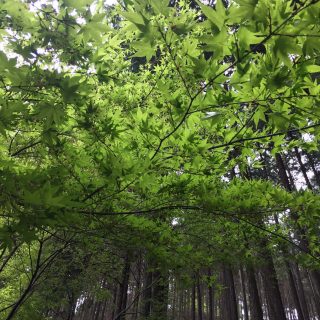If you walk the main street in Yoshino, you may notice a large, reddish-white statue of a three-legged toad. Toad and frog carvings, key chains, and other souvenirs are common in the town. They’re related to a story from Kinpusenji Temple about an impudent man who was hung from a cliff because he made fun of a mountain ascetic (yamabushi). When the man regretted his actions, a Kinpusenji high priest saved him by turning him into a frog. The priest later changed him back into a man by bringing him before a statue of the Buddhist-Shinto deity Zao Gongen and invoking its magic powers. The tale is remembered every year at the temple’s Kaerutobi or Frog-hopping Festival. Of all these frogs and toads, a toad statue in the shopfront at Fujii Daranisuke-Gan stands out because it’s the larger of a pair, and both have only three legs.
In front of the shop Fujii Daranisuke-Gan are two toad statues with only three legs, one particularly notable because of its large size. Three-legged animals like the Yatagarasu three-legged crow, the mascot of the Japan Football Association, are associated with Shinto, good fortune, and rebirth. Curious to know more about the toads, I entered Fujii Daranisuke-Gan and was greeted by its ninth-generation owner. Surrounded by antiques decorating the tatami-mat rooms, he explained that Fujii Daranisuke-Gan was founded in the 1940s, but its family history goes back much further, making it one of the oldest manufacturers in Yoshino. The shop makes a popular herbal remedy for gastrointestinal ailments that is also known as Daranisuke-Gan. Long used by ascetic religious practitioners, the remedy has a unique history that reflects the evolution of Yoshino itself.
Yoshino began as a center for ascetic training for practitioners of Shugendo, a belief system made up of a mixture of Buddhism, Shinto and local folk beliefs. En no Gyoja was a seventh-century mystic who is considered the founder of Shugendo. He not only laid the groundwork for the growth of Shugendo but conducted detailed research on herbal remedies. At the time epidemics were rampant and medical care primitive. A toad appeared in En no Gyoja’s dream and gave him a recipe for a stomach ailment remedy. He is said to have prepared large amounts of this remedy in a caldron and given doses to those in need.
En no Gyoja’s followers handed down the recipe for this remedy, which Fujii Daranisuke-Gan continues to produce. It takes one month to prepare from carefully selected organic ingredients such as the bark of the cork tree, powdered herbs from the Swertia, Gentian, Plectranthus, and Geranium families, and rice flour.
The remedy is said to be effective for a range of stomach problems including indigestion, heartburn, and nausea, as well as lack of appetite and hangover. The pills are to be taken three times a day with water after meals, and the dosage for adults is 20 pills each time. Fortunately, the pills are quite small and can be taken with a special spoon, included with each container that scoops out 10 pills at a time.
In recent years, Daranisuke-Gan has become popular among vegans and people who buy organic products. The bright green design of the package with its three-legged toad logo is immediately recognizable. If you often suffer the effects of drinking too much or have a history of stomach woes, Daranisuke-Gan might be the best souvenir you can find in Yoshino.




